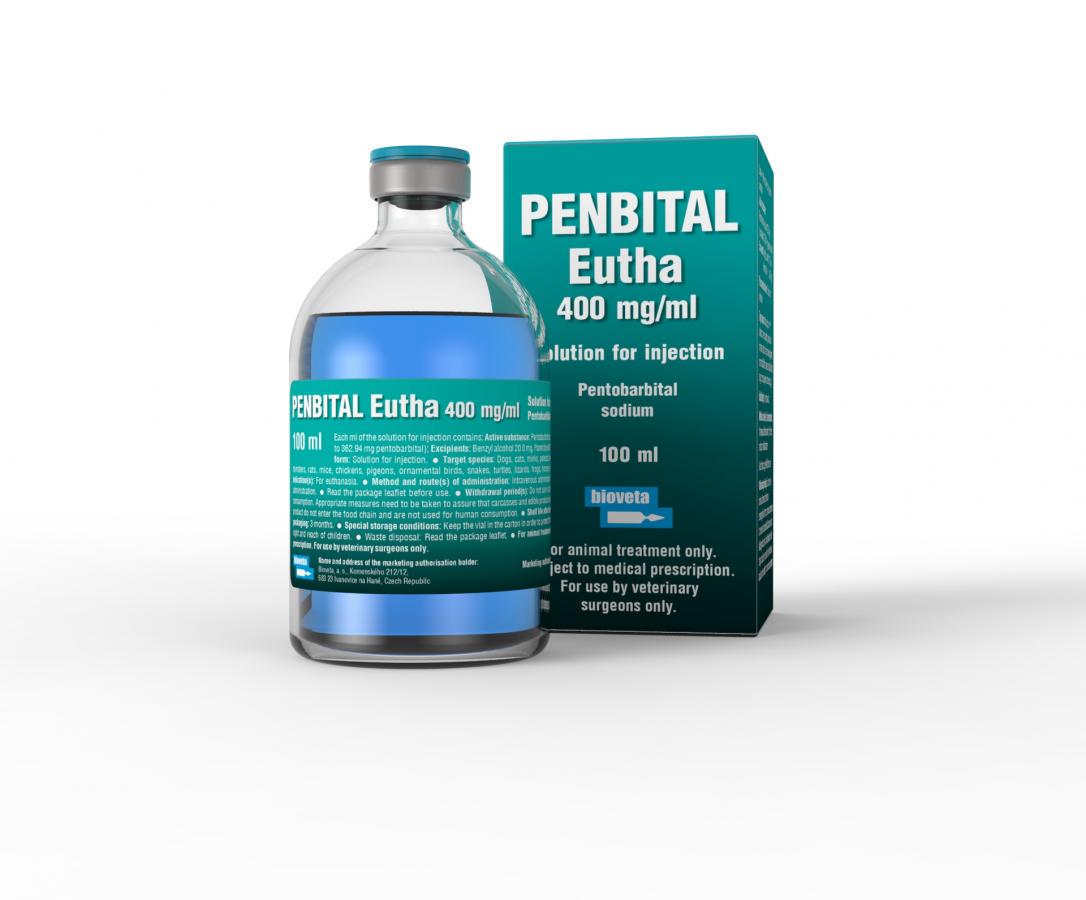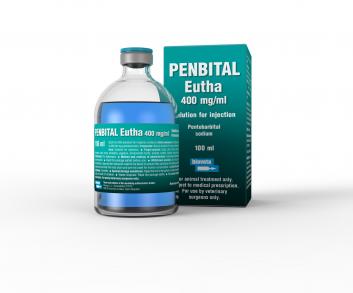PENBITAL Eutha 400 mg/ml solution for injection
Homepage Products Veterinary products PENBITAL Eutha 400 mg/ml solution for injection
Solution for injection containing pentobarbital for painless and calm euthanasia of animals.
| type of preparative: | Other products |
|---|---|
| target species animals: | Dog, Cat, Rabbit, Poultry, Pig, Cattle, Fur-bearing animal |
PHARMACEUTICAL FORM
Solution for injection.
Clear, blue solution.
COMPOSITION
Active substance:
Pentobarbital sodium 400.0 mg (equivalent to 362.94 mg pentobarbital)
Excipients:
Benzyl alcohol 20.0 mg
Patent blue 0.006 mg
INDICATION
For euthanasia.
TARGET ANIMALS
Dogs, cats, minks, polecats, hares, rabbits, guinea pigs, hamsters, rats, mice, chickens, pigeons, ornamental birds, snakes, turtles, lizards, frogs, horses, ponies, cattle and pigs.
CONTRAINDICATIONS
Do not use for anaesthesia.
Do not administer into the coelom in turtles as death may be delayed compared to intravenous administration.
SPECIAL WARNINGS FOR EACH TARGET SPECIES
Make sure that brain death (respiratory and cardiac arrest, loss of corneal and pupillary reflex, or absolute areflexia) has occurred in the animal.
Pigs: In pigs, a direct relationship was found between restriction of movement and the degree of excitation and agitation. For this reason, injection should be administered with the least possible restriction of movement.
If possible, do not make any fixation (for intracardiac administration) or reduce fixation to a minimum. If fixation is necessary, use the fixation loop attached to the upper jaw.
SPECIAL PRECAUTIONS FOR USE
Special precautions for use in animals
In the event of accidental administration to an animal not presented for euthanasia, immediately take appropriate life saving measures. Ensure the support of essential life functions, especially respiratory and cardiovascular. Analeptics are appropriate antidotes.
DOSAGE AND APPLICATION
Intravenous administration, if possible. If this route of administration is not appropriate, other routes of administration are intracardiac, intrapulmonary, intraperitoneal and intraabdominal. The method of administration and the choice of any previous suitable sedation or anaesthesia are at the discretion of the veterinary surgeon. Intracardiac injection is acceptable only after deep sedation or anaesthesia.
The dose administered depends on the species of animal and the route of administration (see the table below).
Table
| Method of administration | [ml] of product per [kg] of body weight |
Dogs
| Intravenous administration: continuous administration until loss of consciousness, then rapid administration of the remaining amount | 1 ml per 3-5 kg of body weight |
|
Intracardiac, intrapulmonary and intraperitoneal administration in unconscious or deeply sedated dogs |
1 ml per 3-4 kg of body weight |
Cats
| Intravenous administration: continuous administration until loss of consciousness, then rapid administration of the remaining amount | 1 ml per 2-3 kg of body weight |
| Intracardiac, intrapulmonary and intraperitoneal administration after SC or IM anaesthesia | 1 ml per kg of body weight |
Minks, polecats
| Intravenous administration | 1 ml per animal |
| Intracardiac, intrapulmonary administration using a needle about 4 cm long in the front part of the sternum (craniodorsal route) | 1 ml per animal |
Hares, rabbits, guinea pigs, hamsters, rats, mice
| Intravenous and intracardiac administration | 1 ml per 1-2 kg of body weight |
| Intrapulmonary administration | 1 ml per 1-2 kg of body weight |
| Intraperitoneal and intraabdominal administration | 1 ml per 0.5-1 kg of body weight |
Chickens, pigeons, ornamental birds
| Intravenous administration | 1-2 ml per 1 kg of body weight |
| Intrapulmonary administration | 1-2 ml per 1 kg of body weight |
Small snakes, lizards and frogs
|
Depending on the size of the animal 0.5-1.0 ml per animal into the body cavity near the heart. Death occurs after 5 to 10 minutes. |
Turtles
| Depending on the size of the animal 0.5-1.0 ml per animal intravenously. Death occurs after 5 to 10 minutes. |
Horses, ponies
| Rapid intravenous administration | 1 ml per 4.5-5 kg of body weight |
Cattle
| Rapid intravenous administration | 1-2 ml per 10 kg of body weight |
Pigs
|
Rapid intravenous administrationinto the vena cava cran. or the ear vein or intracardiac administration
|
0.1 ml per kg of body weight >30 kg 0.2 ml per kg of body weight<30 kg |
Pigs:
Division into groups according to the weight of animals and the route of administration:
| Piglets (up to 8 kg of body weight) | intravenous (vena cava cranialis) or intracardiac administration |
| Weaners (8 - 25 kg of body weight) | intravenous (vena cava cranialis or ear vein) or intracardiac administration |
| Prefattening pigs (25 - 40 kg of body weight) | intravenous (vena cava cranialis or ear vein) or intracardiac administration |
| Fattening pigs (40 - 100 kg of body weight) | intravenous (vena cava cranialis or ear vein) or intracardiac administration |
| Boars and sows (over 100 kg of body weight) | intravenous administration (ear vein) |
The stopper can be punctured up to 50 times.
STORAGE
This veterinary medicinal product does not require any special temperature storage conditions.
Keep the vial in the carton in order to protect from light.
WITHDRAWAL PERIOD
Do not use in animals intended for human consumption.
Appropriate measures need to be taken to assure that carcasses and edible products of animals injected with this product do not enter the food chain and are not used for human consumption.
SHELF LIFE
Shelf life of the veterinary medicinal product as packaged for sale: 3 years.
Shelf life after first opening the immediate packaging: 3 months.
PACKAGE
100 ml.










